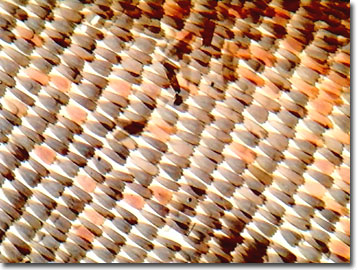Butterfly Wing Scale Digital Image Gallery
White Lady Swallowtail Butterfly
Despite its name, the white lady swallowtail is not completely colorless, but instead displays black markings on its white wing backgrounds. Over-harvesting and habitat destruction continually threaten the species and in Equatorial Guinea, Togo, and Angola, the butterflies are considered endangered.

Classified by entomologists as Graphium angolanus, white lady swallowtail butterflies prefer to inhabit woodlands, but also frequent savannah, bush country, and forest margins. The fast flying butterflies have a wingspan of about 80 millimeters and are unusually bold, exhibiting the strange habit of frequently flying at human eye level. The apparent disregard for danger may be linked to the adults' wing shape and coloration, which protects them through imitation of the toxic friar butterfly. The white lady swallowtail is a Batesian mimic and is not believed to be toxic to birds and other predators.
The plant preferences of white lady swallowtails make them unpopular at times. Their favored egg host and larval food plant is the economically important white custard apple. The fruit, which tastes similar to a mixture of pineapple and apricot, is very popular in Africa, where people often consume them along with the leaves and flowers of the custard apple plant. Due to their herbivory, white lady swallowtail caterpillars are often perceived as agricultural pests and are, consequently, frequently sprayed with insecticides.
Human encroachment, war, and economic hardship have all caused problems for the white lady swallowtail in its native range. Moreover, artificial rearing of the species is quite limited due to the difficulties associated with obtaining and raising the host plants. A trend of low-impact land management practices provides some hope, however, for the tropical lepidopterans. Heightened awareness through public education at butterfly conservatories in Europe and North America and eco-tours of African butterfly ranches may result in additional benefits for the fragile species.
Contributing Authors
Cynthia D. Kelly, Shannon H. Neaves, Laurence D. Zuckerman, and Michael W. Davidson - National High Magnetic Field Laboratory, 1800 East Paul Dirac Dr., The Florida State University, Tallahassee, Florida, 32310.
BACK TO THE BUTTERFLY WING SCALE IMAGE GALLERY
BACK TO THE DIGITAL IMAGE GALLERIES
Questions or comments? Send us an email.
© 1995-2025 by Michael W. Davidson and The Florida State University. All Rights Reserved. No images, graphics, software, scripts, or applets may be reproduced or used in any manner without permission from the copyright holders. Use of this website means you agree to all of the Legal Terms and Conditions set forth by the owners.
This website is maintained by our
Graphics & Web Programming Team
in collaboration with Optical Microscopy at the
National High Magnetic Field Laboratory.
Last Modification Friday, Nov 13, 2015 at 02:19 PM
Access Count Since January 21, 2003: 9072
Visit the website of our partner in introductory microscopy education:
|
|
